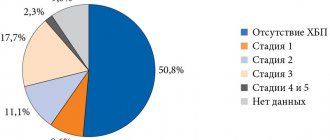Atypical neuroleptic. Synonyms for clozapine: azaleptin, leponex, alemoxan, clazaril, iprox. In our country it is sold in two forms: azaleptin and leponex.
Clozapine
- one of the most powerful antipsychotics available today. It is included in the list of potent psychotropic drugs and therefore its circulation is especially controlled by the state (illegal trafficking may result in criminal liability).
In hospitals it is subject to special control and recording. It is prescribed to patients on special forms of strict accounting on numbered prescriptions of a special form: 148-1/u-88. Of all the antipsychotics, only two drugs have such enhanced control over their distribution and use: clozapine and levomepromazine (tisercin).
It was synthesized back in the 60s of the 20th century, the first experience of its use was in 1971, but it became widely used only in 1990. He is considered the founder of the second generation of antipsychotic drugs - atypical antipsychotics.
Unlike first-generation drugs, clozapine is able to influence negative symptoms (apathy, passivity, decreased emotions, withdrawal) and is noticeably less likely to cause extrapyramidal disorders.
Later, new antipsychotic drugs appeared and continue to appear, some of them are falling out of use, but clozapine is still widely used throughout the world as one of the most powerful antipsychotic drugs.
The mechanism of action is complex: it blocks dopamine (especially D-4) receptors in the brain. In addition, it has a similar effect on acetylcholine, adrenaline, histamine, GABA and serotonin receptors. Due to this, a strong sedative effect is achieved, excitement, impulsivity, and fear are relieved, and productive symptoms of psychosis (delusions, hallucinations) are reduced.
One of the intermediate products of clozapine metabolism is benzodiazepine, the active ingredient of many tranquilizers, which determines the anti-anxiety and hypnotic effects. In some cases, an antidepressant effect may also be observed.
Reasons for using the drug in drug addicts
The pronounced sedative, inhibitory effect of Clozapine has long been known among drug addicts. The drug’s ability to enhance the effect of using other types of illegal drugs (depressants) is also used to obtain euphoria. This drug is used much more often than other antipsychotics for recreational purposes.
Clozapine's ability to make it easier to fall asleep is known among drug addicts. They often cannot rest fully at night, and widely use this antipsychotic to eliminate insomnia. In addition to the mixture, underground manufacturers of synthetic substances may use Azaleptin or another type of antipsychotic to potentiate the effect. They care little about the consumer's health; making a profit is much more important to them.
In terms of the degree of anticholinergic effect on the body, Clozapine is often compared with Tropicamide. The latter remedy comes in the form of drops and is considered by many as a cheap type of drug. Since 2013, Azaleptin has been included in the list of potent drugs in the Russian Federation. Its sale without a special prescription form is prohibited by law.
Clozapine
After attending a congress on schizophrenia (Berlin) in the fall of 2013, my understanding of clozapine expanded. A number of reports presented at the congress were devoted specifically to the treatment of schizophrenia with clozapine, and most of the messages were positive. It seemed that rumors of severe side effects of clozapine were clearly exaggerated. I began to prescribe this drug more often and even combine it for a short time (2-3 weeks) with other antipsychotics (olanzapine), especially if I encountered cases of resistant hallucinations or delusions and even manic states as part of bipolar affective disorder. It is traditionally believed that clozapine cannot be considered a first-line drug for the treatment of psychosis, primarily because of its side effects (the risk of developing agranulocytosis), and not because of its therapeutic profile. At the same time, there is a widespread belief among psychiatrists that the effect of clozapine is especially positive if it is used for a relatively long time (3–7 months) in small or medium doses. Let us note another positive effect of clozapine, in contrast to other atypical antipsychotics, not to mention traditional antipsychotics, during its treatment, patients are much less likely to interrupt the full course of treatment; in this regard, only olanzapine comes close to clozapine. Psychiatrists with extensive practical experience also know that clozapine eliminates manifestations of aggression and hostility caused by the development of negative and productive symptoms in schizophrenia; it softens the character of patients, making them less categorical, conflict-ridden and stubborn. However, I would like to emphasize that in order to reduce the level of aggressiveness, patients must take clozapine for a relatively long time. Clozapine is extremely important in terms of preventing suicide in patients with schizophrenia and depression, which manifests itself as a feeling of hopelessness and hopelessness. There is an indication in the literature that clozapine may be useful in the treatment of polydipsia-hyrponatremia syndrome, the latter, as is known, can lead to the development of convulsive syndrome. Speaking about clozapine, it is worth saying that in patients with schizophrenia who abuse alcohol or cannabinoids, clozapine is also useful because it weakens the severity of craving for ethanol and, as mentioned above, reducing the level of aggressiveness. With long-term use, for example, for a year, clozapine significantly reduces the risk of relapse of schizophrenia.
Withdrawal syndrome
The drug has the property of being addictive. For this reason, in patients it is withdrawn slowly, gradually reducing the dose over several weeks. If a drug addict cannot take another dose for a certain reason, this leads to a strong withdrawal syndrome. It is accompanied by the following symptoms:
- irritability and aggression
- hypermobility
- tremors and convulsions
- hallucinations (most often visual, but can also be auditory)
- delirium and clouding of consciousness
Indications for taking clozapine
- Psychosis with no effect from taking other antipsychotics.
- Schizophrenia
- Organic schizophrenia-like disorder
- Manic psychosis.
- Psychomotor agitation.
- Aggressiveness.
- Severe forms of insomnia.
- Personality disorders (psychopathy), decompensation.
- Derealization and depersonalization in depression.
- Suicidal behavior
The therapeutic effect develops gradually. Relief from agitation, aggressiveness and insomnia occurs within the first 24 hours. Antidelusional, antimanic and antipsychotic effect - within a month.
In a healthy person, taking clozapine can cause a state of indifference and apathy.
Clozapine
Potentially serious side effects of Clozapine are granulocytopenia and agranulocytosis, the incidence of which is 3% and 0.7%, respectively. Agranulocytosis can be life-threatening.
Since the widespread use of white blood cell and absolute neutrophil counts, the incidence of agranulocytosis and the mortality rate among patients who develop agranulocytosis have decreased markedly. For this reason, the precautions below are mandatory.
Clozapine should only be used in patients with schizophrenia or in patients with psychosis associated with Parkinson's disease who have shown no or insufficient response to treatment with other antipsychotic drugs or who experience severe extrapyramidal side effects with other antipsychotic drugs (especially , tardive dyskinesia).
Clozapine may also be used in patients with schizophrenia or schizoaffective disorder who, based on their history and current clinical presentation, are believed to be at long-term risk of recurrent suicidal behavior.
In patients of all of these categories, Clozapine is used under the following conditions:
- before treatment, both the number of leukocytes (≥ 3.5x109/l [3500/mm3]) and the number of other blood cells should be normal;
- Patients should be regularly monitored for white blood cell counts and, if possible, absolute neutrophil counts (ANC) during treatment (weekly for the first 18 weeks and then at least once a month) and for 1 month after permanent discontinuation of clozapine.
Clozapine is contraindicated in patients who have had hematological disorders in the past while taking medications.
Physicians using the drug must fully comply with safety requirements.
During each consultation, patients receiving clozapine should be reminded that if they exhibit any signs of an infectious disease, they should contact their physician immediately. Particular attention should be paid to complaints of flu-like symptoms or other signs of infectious diseases (particularly fever or sore throat), which may indicate neutropenia. In such cases, a complete blood count should be performed immediately.
Special precautions
Hematological parameters
Since Clozapine may cause agranulocytosis, the following precautions must be observed.
Along with the drug Clozapine, you should not use medications that can significantly inhibit hematopoiesis. You should also avoid simultaneous use of Clozapine with depot forms of antipsychotic drugs, since such drugs can inhibit hematopoiesis, and in an emergency situation (for example, with granulocytopenia), rapid removal of such dosage forms from the body is impossible.
In patients with a history of primary bone marrow diseases, clozapine should be used only if the expected benefit outweighs the possible risk. Such patients should be carefully examined by a hematologist before starting treatment.
Before using clozapine in patients with a low white blood cell count due to benign ethnic neutropenia, the consent of a hematologist should be obtained.
Monitoring white blood cell count and ANC
10 days before starting treatment with Clozapine, the white blood cell count and other blood cell counts should be determined to ensure that only patients with normal values (white blood cell count ≥ 3.5 x 109/L [3500/mm3]) and ANC ≥ will receive the drug. 2.0×109/l [2000/mm3]). During the first 18 weeks of treatment, the number of leukocytes and ANC should be determined every week, and during further treatment - at least once a month; These parameters should also be monitored for one month after discontinuation of the drug Clozapine. During each consultation, patients receiving clozapine should be reminded that at the first sign of fever, sore throat, other flu-like symptoms, and especially other symptoms of an infectious disease that may indicate neutropenia, they should immediately contact their healthcare provider. doctor. In such cases, the leukocyte formula should be immediately determined.
Interruption of therapy due to non-hematological reasons
For patients in whom clozapine therapy of more than 18 weeks was interrupted for more than 3 days (but less than 4 weeks), weekly monitoring of the white blood cell count for an additional 6 weeks is indicated. If no abnormalities are detected, you can proceed to monitoring blood counts at intervals of 4 weeks (but not less often). If clozapine therapy is interrupted for 4 weeks or more, blood counts should be monitored weekly for the subsequent 18 weeks of treatment.
Low white blood cell count and ANC
If in the first 18 weeks of treatment with Clozapine the number of leukocytes decreases to 3.0-3.5910 / l (3000-3500 / mm3) and / or ANC decreases to 1.5-2.0 × 109 / l (1500-2000 / mm3), a general blood test must be performed at least 2 times a week. The same requirement also applies if after 18 weeks of treatment the number of leukocytes decreases to 2.5-3.0x 109/l (2500-3000/mm3) and/or ANC decreases to 1.0-1.5x109 /l (1000-1500/mm3).
If the number of leukocytes decreases significantly relative to the initial value, it is necessary to re-determine the number of leukocytes and the leukocyte formula.
A “significant” decrease is defined as a single decrease in white blood cell count of 3.0 x 109/L (3000/mm3) or more, or a cumulative decrease of 3.0 x 109/L (3000/mm3) or more over a 3-week period.
Clozapine should be discontinued immediately if, in the first 18 weeks of treatment, the leukocyte count decreases to <3.0 x 109/L (3000/mm3) or the ANC decreases to <1.5 x 109/L (1500/mm3), or if after 18 weeks of treatment, the number of leukocytes decreases to <2.5 109/l (2500/mm3) or the ANC decreases to <l.0x109/l (1000/mm3).
Thereafter, white blood cell and other blood cell counts should be determined daily, and patients should be closely monitored for the development of influenza-like symptoms or other symptoms suggestive of an infectious disease. After stopping the drug Clozapine, blood counts should be monitored until they return to normal.
If, despite discontinuation of Clozapine, the white blood cell count has decreased below 2.0 x 109/L (2000/mm3) and/or the ANC has decreased below 1.0 x 109/L (1000/mm3), this condition should be treated under the guidance of an experienced hematologist. .
If possible, the patient should be referred to a specialized hematology department, where he can be placed in a separate box and given GM-CSF (granulocyte-macrophage colony-stimulating factor) or G-CSF (granulocyte colony-stimulating factor). It is recommended to discontinue the colony-stimulating factor after the ANC increases again to a level above 1.0x 109/L (1000/mm3).
If an infectious disease develops, antibiotic therapy should be started immediately due to the possibility of septic shock.
In patients who have had Clozapine discontinued due to a low white blood cell count (see above), re-use of Clozapine is not recommended. To confirm the values of hematological parameters, it is recommended to conduct a blood test two days in a row, however, the drug Clozapine should be discontinued after receiving the results of the first test.
If eosinophilia develops, it is recommended to discontinue Clozapine if the eosinophil count exceeds 3.0 x 109/L (3000/mm3), and treatment can be resumed only after the eosinophil count has decreased to a level below 1.0 x 109/L (1000/mm3).
In case of thrombocytopenia, it is recommended to discontinue Clozapine if the platelet count decreases to <50 × 109/L (50,000/mm3).
Other Precautions
Cardiotoxicity
In patients with heart disease, the drug should be used in a low initial dose (on the first day - 12.5 mg in one dose). The dose should be increased slowly and gradually. For dosing accuracy, clozapine 25 mg scored tablets from another manufacturer should be used. The drug is contraindicated in patients with severe cardiovascular diseases. Patients with a history of heart disease or whose physical examination reveals cardiac abnormalities should be referred to a specialist for further evaluation, which should include an ECG. In such patients, Clozapine should only be used if the expected benefit outweighs the possible risk. The treating physician should consider performing an ECG before starting treatment.
Orthostatic hypotension with or without fainting may occur with the use of Clozapine. In rare cases (approximately one in 3000 patients), collapse can be severe and may cause circulatory and/or respiratory arrest, possibly leading to death. The likelihood of such phenomena increases at the stage of initial dose selection (especially in the case of rapid dose increases); very rarely they occurred even after the first use of the drug. Such complications appear to occur more frequently when the drug is used concomitantly with benzodiazepines or other psychotropic drugs. In this regard, at the beginning of treatment with Clozapine, it is necessary to ensure careful medical supervision of the patient.
In the first two months of treatment, in rare cases, resting tachycardia may occur, accompanied by arrhythmia, shortness of breath or symptoms of heart failure; in very rare cases, these phenomena may occur at later stages of treatment. If such symptoms occur (especially during dose selection), diagnostic measures should be carried out as early as possible in order to exclude myocarditis. Symptoms of clozapine-induced myocarditis may also resemble those of a myocardial infarction or the flu. There have also been cases of fatal myocardial infarction. However, due to the patients' severe pre-existing heart disease prior to treatment, it was difficult to assess a causal relationship with clozapine use.
If myocarditis or cardiomyopathy is suspected, clozapine should be discontinued immediately and the patient should be promptly referred to a cardiologist.
The same signs and symptoms may occur later in treatment and in very rare cases may be associated with cardiomyopathy. In such cases, further examination is indicated. If the diagnosis of cardiomyopathy is confirmed, Clozapine should be discontinued.
In patients who have experienced myocarditis or cardiomyopathy caused by clozapine, repeated use is not recommended.
In some cases, eosinophilia was observed simultaneously with myocarditis (in approximately 14% of cases) and pericarditis/pericardial effusion; however, whether eosinophilia is a reliable predictor of carditis is unknown. Mitral valve insufficiency may develop in patients diagnosed with cardiomyopathy during treatment with the drug. Case reports have been received of the development of mitral valve insufficiency in patients with cardiomyopathy associated with clozapine therapy. In these cases, two-dimensional echocardiography revealed mild or moderate regurgitation.
In patients with Parkinson's disease, blood pressure should be monitored while standing and lying down during the first weeks of treatment.
QT prolongation
As with other antipsychotic drugs, clozapine is recommended to be used with caution in patients with a family history of CVD or QT disease. As with other antipsychotic drugs, clozapine is recommended to be used with caution concomitantly with drugs that may prolong the QTc interval.
Cerebrovascular events
The use of some atypical antipsychotics in patients with dementia increased the risk of adverse cerebrovascular events by approximately 3 times. The reason why the risk of such events increases has not been established. An increased risk of similar effects cannot be excluded for other antipsychotic drugs or for other categories of patients. In this regard, Clozapine should be used with caution in patients who have risk factors for stroke.
Epilepsy
The drug Clozapine may lower the seizure threshold. Since epileptic seizures have been reported during the use of Clozapine, the frequency and severity of which depended on the dose of the drug, patients with a history of epilepsy should be closely monitored during treatment with Clozapine. In such cases, the dose of the drug should be reduced and, if necessary, anticonvulsant therapy should be started.
In patients with a history of seizures, the dose of the drug on the first day should be 12.5 mg 1 time per day; further increases in the dose should be done slowly and gradually. For dosing accuracy, clozapine 25 mg scored tablets from another manufacturer should be used.
Fever
While taking Clozapine, patients' body temperature may temporarily increase to 38 °C or higher (most likely in the first 3 weeks of treatment). As a rule, such fever is benign. In some cases, it may be accompanied by an increase or decrease in the number of leukocytes.
Patients with fever should be carefully evaluated to exclude infectious disease or agranulocytosis. In case of high fever, the possibility of NMS should be taken into account. If NMS is diagnosed, clozapine should be discontinued immediately and the necessary therapeutic measures should be initiated.
Clozapine may have a sedative effect and cause weight gain, thereby increasing the risk of thromboembolism; for this reason, immobilization should be avoided.
Anticholinergic effects
The drug Clozapine has anticholinergic activity, which can cause side effects from various organs and systems of the body, therefore, in patients with prostate enlargement and angle-closure glaucoma, clozapine should be used under close supervision. Possibly due to its anticholinergic effects, clozapine may cause disturbances in intestinal motility, the severity of which varies from constipation to fecal impaction, intestinal obstruction and intestinal paresis. In rare cases, such phenomena have led to death.
The drug should be used with extreme caution in patients with diseases of the colon or a history of surgical interventions on the organs of the lower abdominal cavity, who are simultaneously receiving drugs that can cause constipation (especially drugs with anticholinergic activity, for example, various antipsychotic drugs, antidepressants and antiparkinsonian drugs ), since the latter can aggravate the situation. Constipation is extremely important to recognize and actively treat.
Particular caution is required when considering the use of Clozapine concomitantly with benzodiazepines (or other centrally acting drugs).
Metabolic disorders
During the use of atypical antipsychotic drugs, including the drug Clozapine, metabolic disturbances were observed, which may increase the risk of developing cardiovascular complications and cerebrovascular accidents. These metabolic abnormalities may include hyperglycemia, dyslipoproteinemia, and weight gain. Although some metabolic abnormalities may occur with all atypical antipsychotic drugs, each drug in this class has its own spectrum of side effects.
Hyperglycemia
Cases of diabetes mellitus and severe hyperglycemia (sometimes leading to ketoacidosis or hyperosmolar coma) have been reported even during the use of clozapine in patients without a history of hyperglycemia. A cause-and-effect relationship between these events and the use of clozapine has not been established, although after discontinuation of the drug in most patients, blood glucose concentrations returned to normal. In a small number of cases, there was a positive association with repeated use of the drug. The effect of clozapine on glucose metabolism in patients with pre-existing diabetes mellitus has not been studied. In patients with diabetes mellitus who are starting to use atypical antipsychotic drugs, serum glucose concentrations should be measured regularly. In patients with risk factors for diabetes mellitus (particularly overweight and a family history of diabetes mellitus) who are starting to use atypical antipsychotic drugs, fasting blood glucose concentrations should be measured before starting treatment and periodically during treatment. If hyperglycemia with symptoms such as polydipsia, polyuria, polyphagia, or weakness occurs in patients using clozapine, the possibility of impaired glucose tolerance should be considered. In patients who develop symptoms of hyperglycemia while using atypical antipsychotics, fasting glucose concentrations should be determined. In some cases, after discontinuation of atypical antipsychotic drugs, glucose concentrations returned to normal; in other cases, hyperglycemia required further treatment despite drug discontinuation. In patients with severe hyperglycemia that has developed while taking the drug, discontinuation of the drug Clozapine should be considered.
Dyslipoproteinemia
Abnormalities in lipid metabolism have been observed in patients using atypical antipsychotic drugs, including clozapine. It is recommended to monitor lipid metabolism in such patients (at the beginning and regularly during treatment).
Weight gain
Weight gain has been reported in patients taking atypical antipsychotics, including clozapine. Body weight should be regularly monitored in such patients.
Special categories of patients
Liver dysfunction
Use of atypical antipsychotic drugs, incl. Clozapine in patients with liver disease is possible with regular monitoring of liver function. If symptoms that may indicate liver dysfunction (such as nausea, vomiting, or loss of appetite) develop during treatment with clozapine, liver function tests should be performed immediately. If there is a clinically significant increase in these values or symptoms of jaundice appear, treatment with Clozapine should be discontinued. Treatment can be resumed only if liver function tests are normalized. In such cases, patients should be closely monitored.
Renal dysfunction
In patients with mild to moderate renal impairment, the drug should be used at a low initial dose (on the first day - 12.5 mg in one dose). For dosing accuracy, clozapine 25 mg scored tablets from another manufacturer should be used.
Patients aged > 60 years
In patients of this age group, it is recommended to start treatment with a lower dose.
Orthostatic hypotension may occur during the use of Clozapine. There have also been rare cases of tachycardia, which may not disappear for a long time. This category of patients, especially patients with impaired cardiovascular function, may be susceptible to these effects to a greater extent than younger patients. In addition, some patients aged >60 years may be particularly susceptible to the anticholinergic effects of clozapine (eg, urinary retention and constipation).
Psychosis/behavioural disorders in patients aged >60 years with dementia
Clozapine is not indicated for the treatment of psychosis/psychotic disorders in patients over 60 years of age with dementia, since the effectiveness and safety of clozapine in patients in this category have not been proven.
The risk of death was increased with the use of atypical antipsychotics in patients aged > 60 years with psychosis/or behavioral disorders due to dementia. Data analysis showed that in patients in this category, the risk of death when using these drugs was 1.6-1.7 times higher than when using placebo. Factors that increase the risk of death with antipsychotic drugs include sedation, cardiovascular disease (eg, arrhythmia, sudden cardiac death), or pulmonary disease (eg, pneumonia with or without aspiration).
Rebound/withdrawal symptoms
If abrupt discontinuation of clozapine is necessary (eg, due to leukopenia), the patient should be carefully monitored for return of psychotic symptoms and rebound cholinergic symptoms, particularly sweating, headache, nausea, vomiting, and diarrhea.
Clozapine (Azaleptin, Leponex. Clozasten, Azaleprol)
Indications
Acute and chronic forms of schizophrenia, manic states, manic-depressive psychosis, psychomotor agitation in psychopathy, emotional and behavioral disorders (including in children), sleep disorders.
Contraindications
History of granulocytopenia or agranulocytosis (except for the development of granulocytopenia or agranulocytosis due to previously used chemotherapy), suppression of bone marrow hematopoiesis, myasthenia gravis, comatose states, toxic psychosis (including alcoholic), pregnancy, lactation, children under 5 years of age, increased sensitivity to clozapine.
Dosage
Installed individually. For oral administration, a single dose is 50-200 mg, daily - 200-400 mg. Treatment is usually started with a dose of 25-50 mg, then gradually increased by 25-50 mg per day to 200-300 mg/day over 7-14 days. The daily dose can be used once before bedtime or 2-3 times a day after meals. If treatment is discontinued, the dose should be gradually reduced over 1-2 weeks. After achieving a therapeutic effect, they switch to a maintenance course.
If necessary, clozapine can be administered intramuscularly.
The maximum dose when taken orally is 600 mg/day.
In mild forms of the disease, for maintenance therapy, as well as in patients with liver and/or renal failure, chronic heart failure, cerebrovascular disorders, it is prescribed in lower daily doses (25-200 mg).
Side effects
From the central nervous system: drowsiness, headache, rarely - agitation, akathisia, confusion, extrapyramidal disorders (akinesia, hypokinesia, muscle rigidity, tremor), insomnia, restless sleep, depression, NMS, epileptic seizures, tardive dyskinesia, increased temperature of central origin .
From the cardiovascular system: tachycardia, arterial hypotension, orthostatic hypotension, accompanied by dizziness; rarely - flattening of the T wave on the ECG, arterial hypertension.
From the digestive system: hypersalivation, nausea, vomiting, dry mouth, heartburn.
Metabolism: weight gain, increased sweating.
From the hematopoietic system: rarely - eosinophilia, granulocytopenia up to agranulocytosis, leukopenia, thrombocytopenia.
Effects due to anticholinergic activity: dry mouth, accommodation disturbances, constipation, urination problems.
Other: myasthenia gravis, decreased potency, impaired accommodation.
Drug interactions
When used simultaneously with drugs that have a depressant effect on the central nervous system (including benzodiazepine derivatives), ethanol-containing drugs, ethanol, the severity and frequency of manifestations of the inhibitory effect on the central nervous system and increased depression of the respiratory center increase.
When used simultaneously with drugs that cause arterial hypotension, additive hypotensive effects are possible.
When used simultaneously with drugs that cause myelosuppression, the inhibitory effect on bone marrow hematopoiesis may be enhanced; with anticholinergic drugs - the anticholinergic effect may be enhanced.
When used simultaneously with digoxin or with drugs characterized by high protein binding (including heparin, warfarin, phenytoin), their concentrations in the blood plasma may increase, and clozapine may also be displaced by these drugs from the sites of its protein binding.
When used simultaneously with valproic acid, a change in the concentration of clozapine in the blood plasma is possible, while clinical manifestations of the interaction were practically absent.
When used simultaneously with carbamazepine, the concentration of clozapine in the blood plasma decreases. Cases of severe pancytopenia and neuroleptic malignant syndrome have been described.
When used simultaneously with caffeine, the concentration of clozapine in the blood plasma increases and the incidence of side effects may increase.
When used simultaneously with lithium carbonate, myoclonus, convulsions, neuroleptic malignant syndrome, delirium, and psychosis are possible.
When used simultaneously with risperidone, an increase in the concentration of clozapine in the blood plasma is possible, apparently due to a competitive effect on the CYP2D6 isoenzyme, which leads to inhibition of the metabolism of clozapine. When quickly replacing clozapine with risperidone, dystonia may develop.
Rifampicin may increase the rate of metabolism of clozapine by inducing the isoenzymes CYP1A2 and CYP3A.
When used simultaneously with phenytoin, a decrease in the concentration of clozapine in the blood plasma is possible; with fluoxetine, paroxetine, sertraline, fluvoxamine, it is possible to increase the concentration of clozapine in the blood plasma, which in some patients is accompanied by toxicity. This effect is especially pronounced when clozapine is used concomitantly with fluvoxamine.
When used simultaneously with ciprofloxacin, it is possible to increase the concentration of clozapine in the blood plasma.
special instructions
Use with caution in severe diseases of the cardiovascular system, severe renal and/or liver failure, angle-closure glaucoma, prostatic hyperplasia, intestinal atony, epilepsy, intercurrent diseases with febrile syndrome.
During the treatment period, systematic monitoring of peripheral blood patterns is necessary.
When using clozapine, alcohol consumption should be avoided.
The safety and effectiveness of clozapine in children and adolescents under 16 years of age has not been established.
Impact on the ability to drive vehicles and operate machinery
Patients taking clozapine should refrain from potentially hazardous activities that require concentration and increased psychomotor speed.
Pregnancy and lactation
Clozapine is contraindicated during pregnancy and lactation (breastfeeding).
Use in childhood
Contraindicated in children under 5 years of age. The safety and effectiveness of clozapine in children and adolescents under 16 years of age has not been established.
For impaired renal function
Use with caution in severe renal failure. In patients with renal failure, the drug is prescribed at a lower daily dose (25-200 mg).
For liver dysfunction
Use with caution in severe liver failure. In patients with liver failure, the drug is prescribed at a lower daily dose (25-200 mg).
Clozapine: the most effective, but far from safe drug against schizophrenia
Short
A New Zealand study assessing colonic transit time (CTT) using radiopaque markers found that patients treated with clozapine had a median CTT of 104.5 hours - versus 23 hours for those treated with other antipsychotics such as olanzapine, risperidone (risperidone), paliperidone, aripiprazole, zuclopenthixol, haloperidol. Clozapine resulted in a more than fourfold slowing of CTT (p<0.0001), regardless of sex, age, race, duration of therapy, or total drug dose, but with a positive correlation with clozapine plasma levels. In 80% of subjects in the clozapine group, abnormally long CTT was noted in the ascending and descending colon and its rectosigmoid region, which indicates total intestinal hypokinesia. Worse, patients often did not show any subjective symptoms associated with constipation.
Monitoring bowel function and proactive use of laxatives in patients on clozapine therapy has been shown to improve colonic transit time and reduce the risk of serious sequelae.
Clozapine, the originator of atypical antipsychotics as a class of drugs, was introduced in Switzerland and Austria in 1972 under the name Leponex, and entered the US market only in February 1990 under the brand name Clozaril. Clozapine has long been relegated to the category of generic drugs and is known under the following trade names:
- A: Azaleprol, Azaleptin, Azaleptine, Azaleptol, Iqra, Ihope, Alemoxan, Anzapine Anzapine).
- In: Versacloz.
- G: Glipin.
- D: Denzapine, Dicomex.
- Z: “Zaclo”, “Zapine”, “Zapenia” (Zapenia), “Zapine”, “Zaponex”, “Zaporil”, “Ziproc” , "Zopin" (Zopin).
- K: Carapine, Clozabrain, Clozamed, Clozapex, Clozapina, Clozapinum, Klozapol , “Clozarem”, “Clozaril”, “Clozasten”, “Clomach”, “Cloment”, “Clonex”, “Clopaz”, "Clopizam", "Clopin" (Clopin, Clopine), "Clopsine", "Clorazem", "Cloril", "Clorilex", "CloSyn" , "Xenopal" (Xenopal), "Xenopalan" (Xenopalan).
- L: "Lanolept", "Lapenax", "Lepizor", "Leponex", "Lodux", "Lozapin", "Lozapine", "Lozatrik" ( Lozatric), “Lozep”, “Luverina”, “Luften”
- M: Medazepine, Mezapin.
- N: “Nemea”, “Nirva”.
- A: “Ozadep”, “Ozapim”.
- P: “Pinazan”.
- R: “Refraxol”, “Refract”.
- With: "Syzopin", "Syclop", "Sanosen", "Sequax", "Sensipin", "Sizopin", "Sizoril" , “Sicozapina”, “Skizoril”.
- T: “Tanyl”, “Tolanz”.
- U: “Assumption” (Uspen).
- F: FazaClo, Froidir.
- X: Chlorpromazine, Chrozap.
- Sh: "Schizonex" (Schizonex).
- E: Excloza, Elcrit.
AZALEPTINE (tablets)
sleep disturbances if other medications do not help.
Of course, as always, there are a lot of side effects. Reviews about the drug are mostly negative. They were written by patients who took the drug for a long time and became dependent on Azaleptin. The reviews are simply terrible. So I was in no hurry to buy the drug. I consulted with several other specialists who convinced me that I should at least try. The fact is that with constant insomnia, the body does not rest and is therefore in a state of constant stress. The goal of Azaleptin is to help the body relax and unwind. As the psychologist explained to me, the drug promotes muscle relaxation. In addition, it has a strong sedative, that is, hypnotic effect. Plus, this antipsychotic drug can have a relaxing effect on brain cells and help the body get out of depression or prevent it. In general, I decided to buy it. A jar contains 50 tablets of 25 mg each, costing 270 rubles. I was prescribed 1/2 tablet. Pale yellow tablets. Easily broken in half.
The doctor said that after taking the pill, go straight to bed. But, of course, I was interested in how my body would react. That's why I didn't go to bed. I listened to my feelings for two hours. After a while I felt muscle weakness, but it didn’t bother me too much. I didn't feel like falling asleep. But she still lay down. In the morning I came to my senses, realizing that I don’t remember how I fell asleep and slept for 7 hours. I don't even remember if I ever slept like that. I couldn’t get up for a long time. Now I really felt quite a bit of muscle weakness. Fortunately, I conducted the experiment on a weekend night. The next day I took the drug at 8 pm so that all side effects would go away by morning. As a rule, the effect of such drugs lasts about 12 hours. Unfortunately, the second dose of the drug did not give such a hypnotic effect. I slept for 4 hours. But that wasn't bad either. In the morning there was practically no muscle weakness. On the third day, “Azaliptin”, unfortunately, did not help me fall asleep. It is unlikely that in three days it is possible for the body to get used to the drug, but nevertheless, there was no hypnotic result. And muscle weakness was no longer observed. The same thing was observed a week later.
You can, of course, increase the dose and experiment further, but the drug is very serious and I, like everyone else, am afraid of developing an addiction to it. Moreover, the higher the dose, the greater the likelihood of side effects. So I didn’t increase the dose. My doctor and I decided that I would take the drug once a week so that I could sleep at least on weekends. However, the coveted dose of the drug on the weekend did not give the desired result. But I’m still in no hurry to throw it away. The shelf life allows you to store the drug for a long time, which means that over time you can try treatment with it again. Of course, thinking about whether to recommend this drug or not, I come to the conclusion that I will put “yes”, based on the considerations that it can really help someone.








